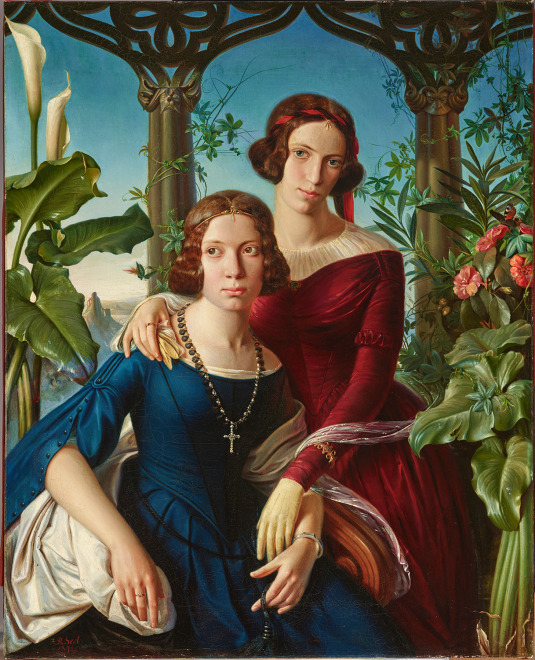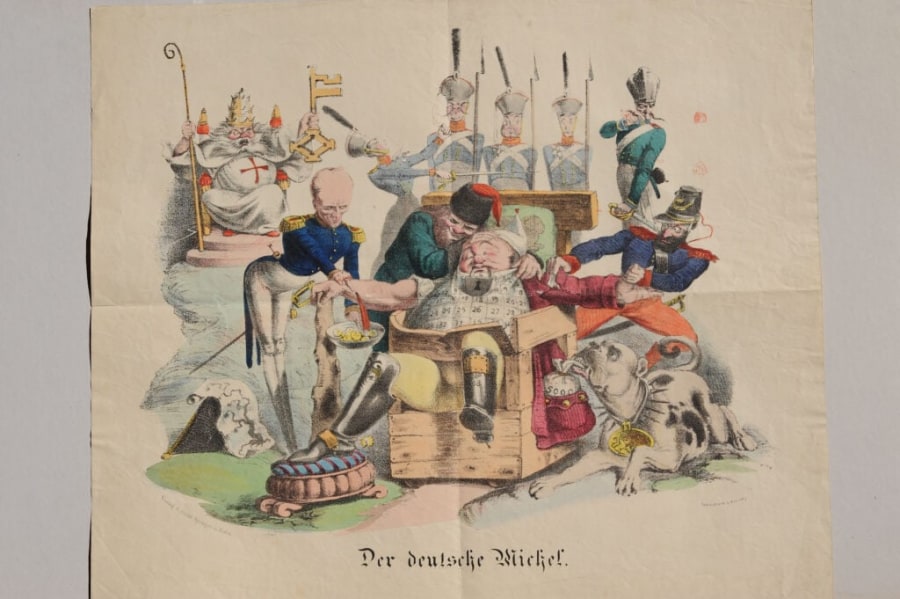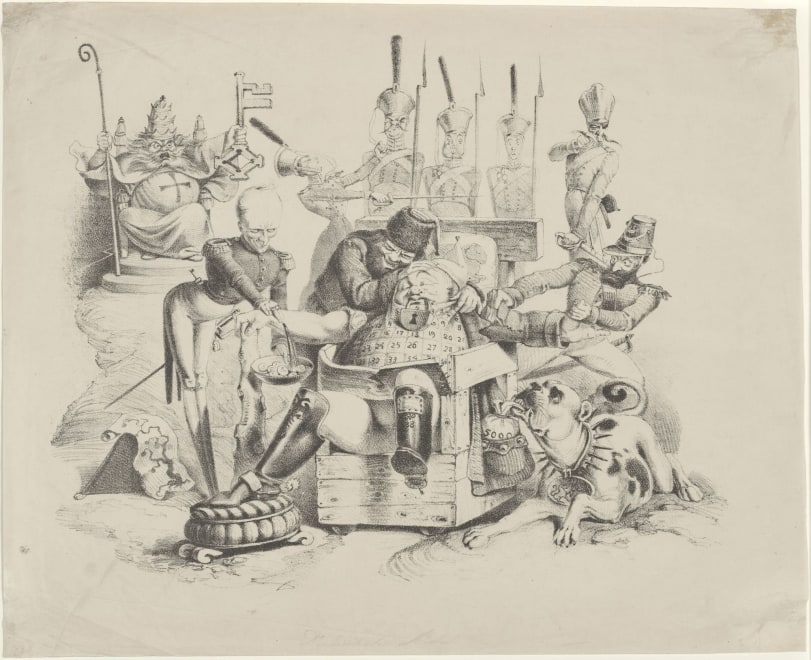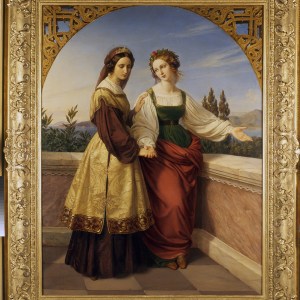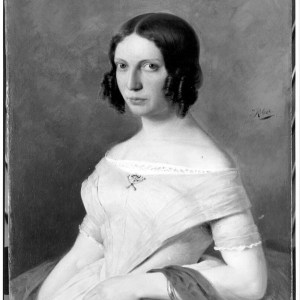Provenance
J. Bloem, Düsseldorf, until 1908
Sale, Grisebach Auktionen, Berlin, 28 November 2012, lot 123
Private collection, California (acquired at the above sale)Exhibited
Elberfeld, Städtisches Museum, Elberfelder Familien portraits, 1907, no. 98
Literature
K. Ammann, “Bildnis und Zeitcharakter,” in Die Rheinlande, vol. 7, March 1907, p. 115
Wilhelm Schäfer, “Elberfelder Familienporträts” Die Rheinlande: Vierteljahrsschrift des Verbandes der Kunstfreunde in den Ländern am Rhein 13, no. 4, April 1907, p.120.
Michael Knieriem, Wir wollen dem Wuppertale eine Ehre machen … Eine Dokumentation zur Entstehungsgeschichte des Elberfelders Literaturkränzchens 1838-1844, Wuppertal, Engelshaus,1994, p.133.
Horst Heidermann, Johann Richard Seel, Maler im Wuppertal und Zeichner des deutschen Michel, Essen, Thales-Verlag, 2003, pp.34-36 (fig. 34 on 35); 130; and 215, cat. no. 35.
Catalogue note
The artistically, musically, and poetically gifted son of a tin caster received his first artistic education in Elberfeld before enrolling in 1837 at the Düsseldorf Academy where he studiedunder Carl Friedrich Sohn (1805-1867). In 1840, or perhaps early 1841, Johann Richard Seel(1817-1875) left for Berlin, where his focus turned to drawing and caricature, and in 1842, he produced his most famous image in that arena, an allegorical commentary on contemporary politics, The Sleeping Michel (Cat. 13a). In contrast to Germania, the Michel does not stand for the nation but the people. As such he is meant to embody the German national character (which some viewers might simply perceive as trotting out German clichés). The widely circulating caricature thematized the suffering inflicted upon German people by their neighboring states, which, as Seel saw it, acted unanimously hostile. Lulled to sleep by the Tsar, robbed by the British Bulldog, reduced to silence by the Pope and bled by the Restoration’s mastermind Prince Klemens Wenzel von Metternich (1773-1859), the sleeping Michel is not even awoken by the attempt of a mean-looking Frenchman to steal his disheveled coat (just like France had tried to annex Alsace). Yet Seel was not letting the German rulers off the hook either. The lock on Michel’s mouth refers to the widespread censorship in those 36 principalities into which Germany was divided, an untenable situation that must, as the uncomfortably crowded pattern of numbers on Michel’s bib suggests, yield unification. Michel’s role as a victim seems pitiful, but self-inflicted, and his dozing body calls out to the German population to “wake up.” Optimistic that the Germans could successfully rise to the challenge, Seel delivered a Hercules club as well, a not too subtle symbol for his own left-leaning sympathies. Before this optimism, however, would be tested on the barricades of the 1848-Revolution, the artist travelled to Paris. There, he encountered the work, and maybe the men as well, of a Paul Delaroche, a Horace Vernet and a Eugène Delacroix, which together made an indelible impression on the young man.
If today Seel is best known for his caricatures, he also enjoyed a stellar reputation as a portraitist in his own time. He had already shown his exceptional talent at the Düsseldorf Academy, and his lush likeness of the sisters Betty and Friderike Bloem, painted during his student days, is a captivating testimony to this talent. In the tradition of the Düsseldorf School, Seel’s portraits excel in psychological depth and finely painted surfaces, which together bring out his sitters’ genuine personalities. In contrast to other portraits, especially of his male sitters, Seel for once decided to accommodate contemporary ideals of beauty and play down the realism he was so famous for. Most of all, the canvas is unique within Seel’s oeuvre for its setting, which, half church, half greenhouse, bursts with gigantic flowers that almost engulf the two sisters. A subtle dualism is set up between the two sisters, one more active, the other more contemplative, a dualism expanded by the flower symbolism into a juxtaposition of virtue and passion, of the calla lily’s purity and the fertile rank growth of a passion fruit. This dualism caused Friedrich Fries (1865-1954) in his 1826 discussion of the double portrait to suggest the The Two Leonores by Seel’s teacher, Carl Friedrich Sohn, as a possible influence (Cat. 13b). Posture and arrangement of the Bloem sisters clearly reflect Sohn’s conception, the first director of Elberfeld’s municipal museum added, but even more so the portrait’s serene nature. Given the age of the artist, who was merely 22, this was indeed an astonishing achievement.
The Bloems played an important role in the Rhinelands, a progressive voice among the region’s bourgeoisie. The sisters’ older brother, Anton (1814-1884), became an influential lawyer that, as a staunch leader of the Düsseldorf democrats and member of the Prussian National Assembly, garnered a reputation as an extraordinary defense attorney, not least of the revolutionaries of 1848. Seel shared the family’s liberal ideals and commitment to democratic politics, and for that reason bonded with the second oldest of the Bloem brothers, Julius (1822-1908), who would later own the double portrait of Betty and Friderike. Together, Seel und Julius Bloem entertained a life-long friendship with Friedrich Engels (1820-1895). Like his older brother, Julius pursued a career in law and he, too, turned out to be a gifted attorney. Yet a poet and writer himself, he also kept close ties with the local art scene, being ultimately elected as an honorary member of Düsseldorf’s free artists’ association, Der Künstlerverein Malkasten. It was here where the brothers met Emanuel Leutze (1816-1868), who, inspired by the 1848-Revolution and the Rhine crossings of the local glee club, was working on his Washington Crossing the Delaware and, on the side, also produced a striking likeness of Anton. The art scene also fascinated the youngest of the Bloem brothers, Gustav (1821-1905), who, of all the siblings, was the most active in this arena. While Gustav thus busily accumulated a remarkable selection of the Düsseldorf School of Painting, he was simultaneously leaving his mark as a trailblazer in the world of ammunition manufacturing.
The sisters were no less interesting. While living in Bad Kreuznach between 1841 and 1847, the youngest, Betty, struck up a friendship with Jenny von Westphalen (1814-1881), the future wife of Karl Marx (1818-1883), and went on to publish an account of a later visit with Jenny in London in the Leipziger Sonntagsblatt (no. 37, 14. Sept. 1862 and no. 41, 12 Oct. 1862). After the marriage to a wealthy manufacturer, cut short after two years by her husband’s unexpected death in 1860, she took up writing under the pseudonym “B. Beluty” and proceeded to open a small business herself. Friderike, in turn, never married and instead took care of their mother, who was then living in Düsseldorf at Schwanenmarkt 16. Probably in the same year that Seel painted the two youngest of his friend’s remarkable sisters, he also captured the oldest, Catharina Augustine “Käthe” (1816-1901). While smaller and much simpler in its overall conception, the third likeness stands out for its disarming frankness (Cat. 13c).
The Bloems were a tight family, and this, together with the sheer aesthetic brilliance of the double portrait might explain why the various portraits remained in the family for over half a century. In 1925, Catharina’s likeness found a permanent home in Düsseldorf’s main painting gallery, which had acquired the canvas from the sitter’s daughter that year. By then, however, the trace of the double portrait had gone cold. It had been last seen in 1907, when Julius, then a member of the Committee of the Permanent Art exhibition in the Casino, had lent it to Elberfeld’s municipal museum for an exhibition of local family portrait. Not surprisingly, the canvas attracted considerable attention and was honored with a full-page reproduction in the local newspaper. Rightfully then, Horst Heidermann expressed a deep regret in his 2003 monograph of Seel, the only to date, that this central work had vanished and was only known through a black-and-white photograph. Its reappearance on the art market in 2012—over 100 years after the canvas had been lost to obscurity—is thus truly a stroke of luck. It not only closes a gaping hole in Richard Seel’s oeuvre. It also delivers a powerful image of two women who, with their family, were dedicated to forge a liberal-democratic future for Germany. As such the image is as rare as the women it depicts.
Cat. 13 Figures
Cat. 13a Johann Richard Seel (artist) and Julius Springer (publisher), The German Michel, 1842, lithography on paper, 40.5 x 50 cm, Heinrich-Heine-Institut, Düsseldorf.
Cat. 13b Carl Ferdinand Sohn, The Two Leonores, 1834, oil on canvas, 216 x 174 cm, Rheinisches Landesmuseum, Bonn.
Cat. 13c Johann Richard Seel, Catharina Augustine “Käthe” Bloem, circa 1841, oil on canvas, 70 x 54 cm, Museum Kunstpalast, Düsseldorf.

